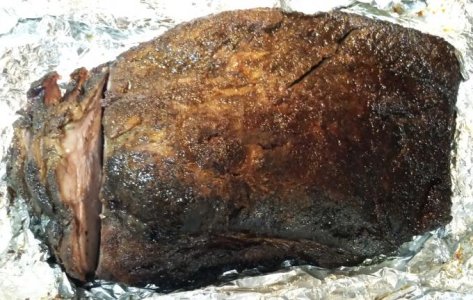I'm planning to smoke my first brisket beginning this Saturday afternoon. It's a full packer weighing in at 12.66 pounds. I think it will fit whole in my #2 if I place it corner to corner on the rack. I'm allowing up to 16 hours @ 225 (not a hard limit, just a plan) before having to pull it out of the smoker. I'll be metering it with two probes and waiting for a good indication that it's hit 195 before messing with it. I think I'll use hickory and pecan.
So... here come the questions.
Brining - How important is it? What are the benefits? What is the shortest effective brining period? Will I hate myself if I skip it?
Prep I'm planning to do yellow mustard and a simple rub (garlic powder, onion powder, salt, pepper) all over. How much seasoning is too much? How much is too little? Should the fat cap be scored? Is four hours rest after applying the rub acceptable? Can it realistically be shorter? Is there a benefit to waiting longer? Any secrets in this stage that I should know and consider?
Placement - I'm still a noob, so I'm being overly cautious. It should be placed with the fat cap up, correct? I mentioned that I think it will fit whole if I put it diagonal on the rack... will it be problematic if it comes in contact, very minimally, with any of the interior of the smoker? Even if that isn't ideal, would it still be better than cutting it in half and smoking it on two racks?
Other - How many ounces of wood should I consider for this smoke? Once it's done (by touch / feel) I'll pull it, wrap it well in foil, wrap that in a towel, and throw it in a cooler to rest for some number of hours. Do I need to worry about it falling apart when trying to pull it out of the smoker? Do folks usually just dump it from the rack onto a baking sheet to bring it inside and do the wrapping bit?
What am I totally leaving out?
Thanks in advance everyone!
So... here come the questions.
Brining - How important is it? What are the benefits? What is the shortest effective brining period? Will I hate myself if I skip it?
Prep I'm planning to do yellow mustard and a simple rub (garlic powder, onion powder, salt, pepper) all over. How much seasoning is too much? How much is too little? Should the fat cap be scored? Is four hours rest after applying the rub acceptable? Can it realistically be shorter? Is there a benefit to waiting longer? Any secrets in this stage that I should know and consider?
Placement - I'm still a noob, so I'm being overly cautious. It should be placed with the fat cap up, correct? I mentioned that I think it will fit whole if I put it diagonal on the rack... will it be problematic if it comes in contact, very minimally, with any of the interior of the smoker? Even if that isn't ideal, would it still be better than cutting it in half and smoking it on two racks?
Other - How many ounces of wood should I consider for this smoke? Once it's done (by touch / feel) I'll pull it, wrap it well in foil, wrap that in a towel, and throw it in a cooler to rest for some number of hours. Do I need to worry about it falling apart when trying to pull it out of the smoker? Do folks usually just dump it from the rack onto a baking sheet to bring it inside and do the wrapping bit?
What am I totally leaving out?
Thanks in advance everyone!


 Hopefully I didn't just have beginner's luck and this one will turn out as awesome as the last one.
Hopefully I didn't just have beginner's luck and this one will turn out as awesome as the last one.